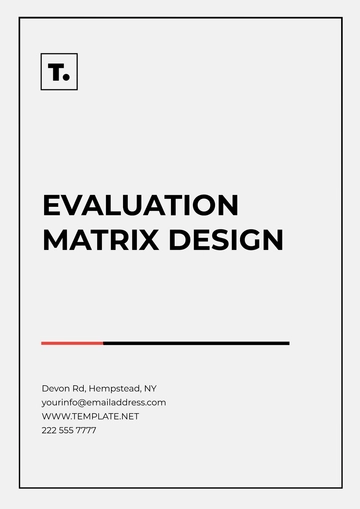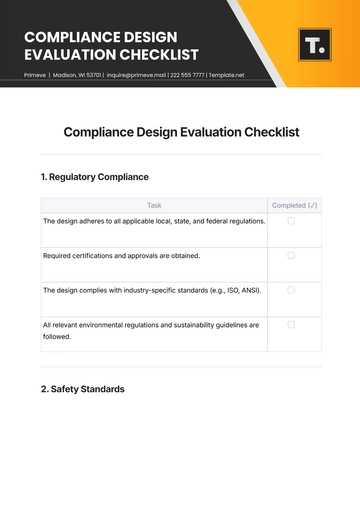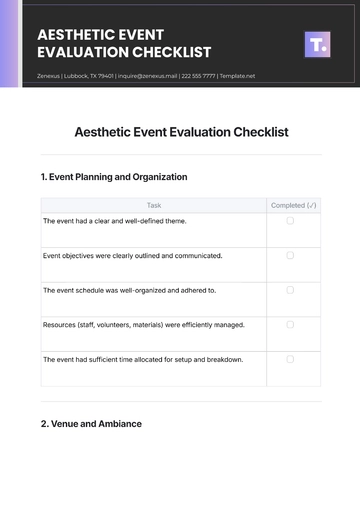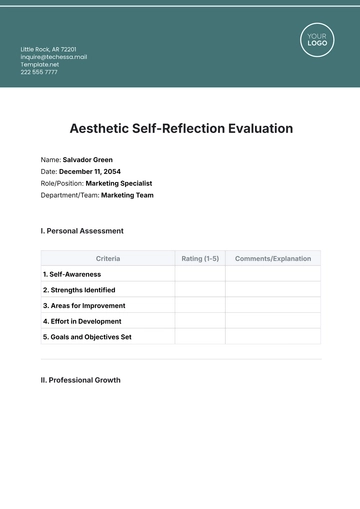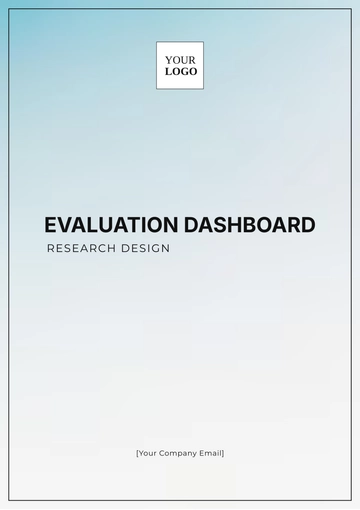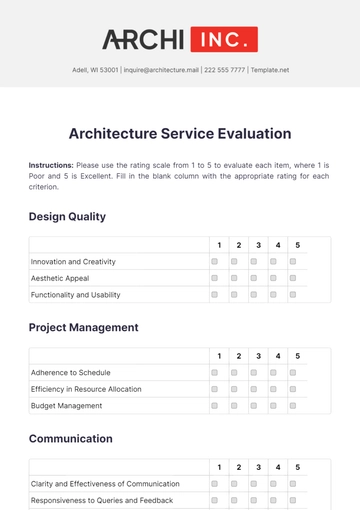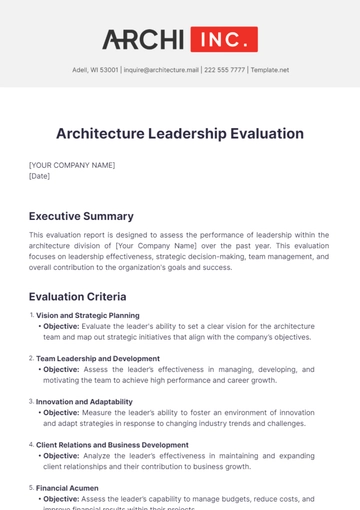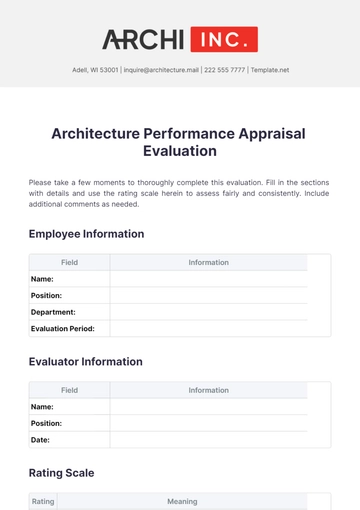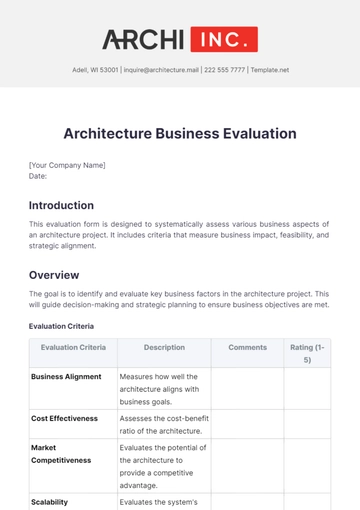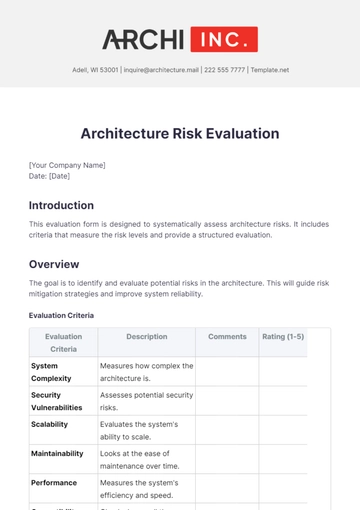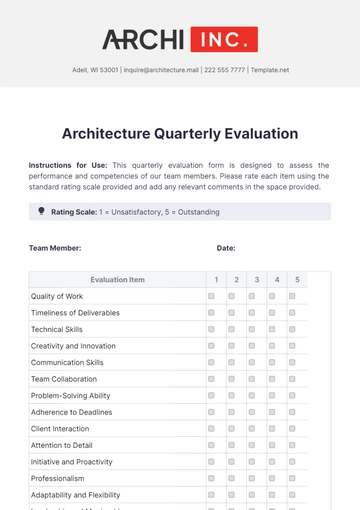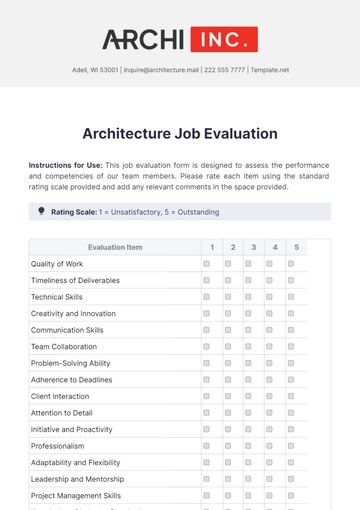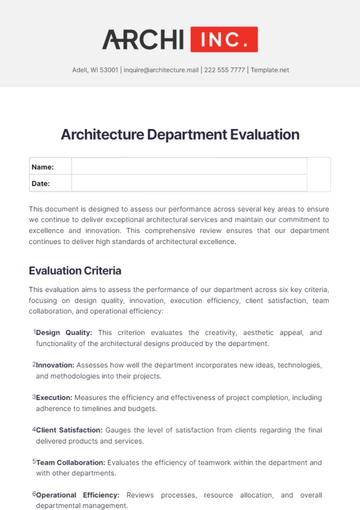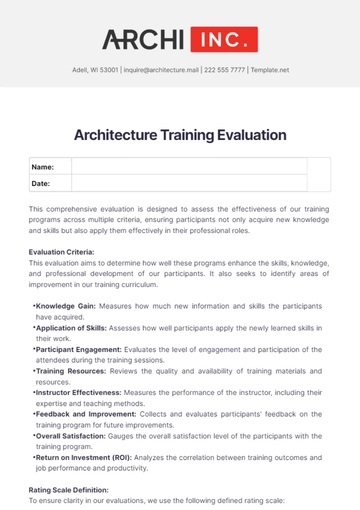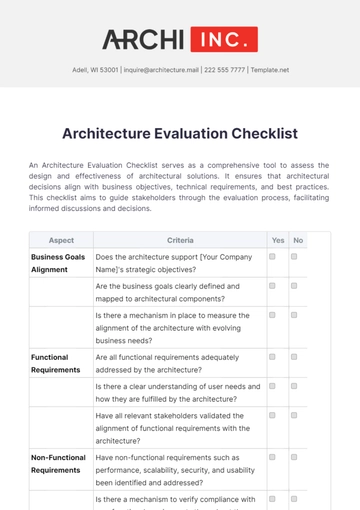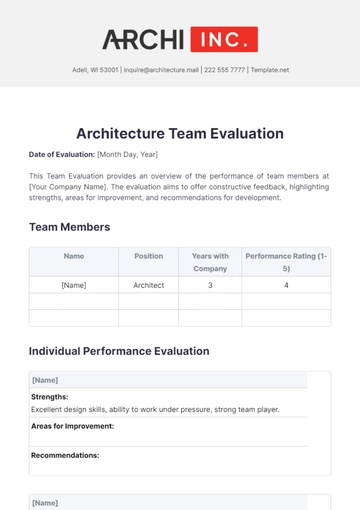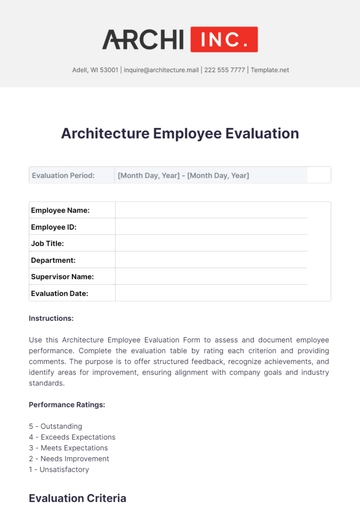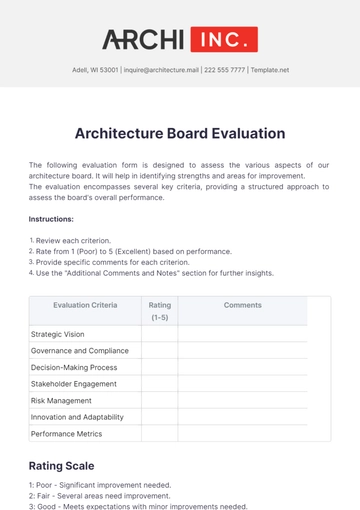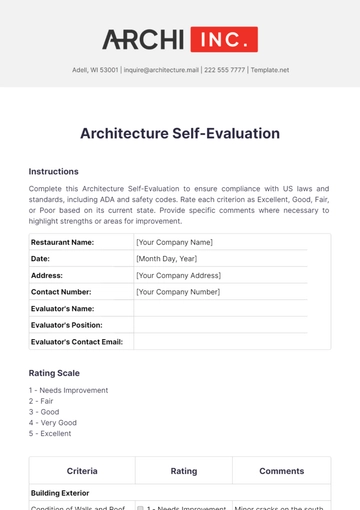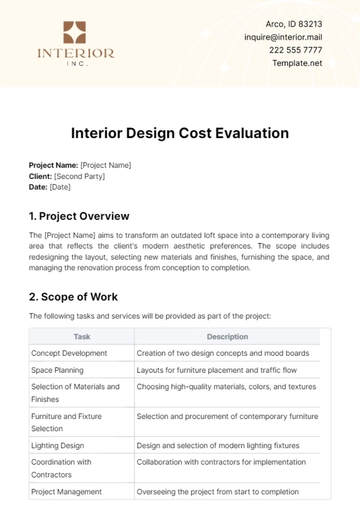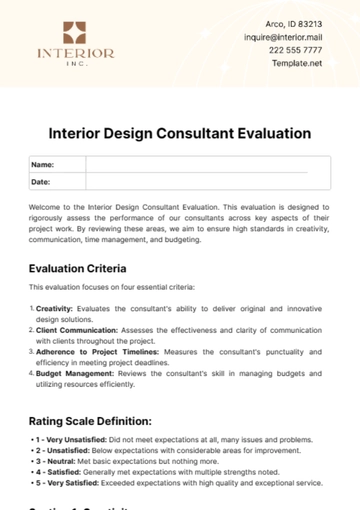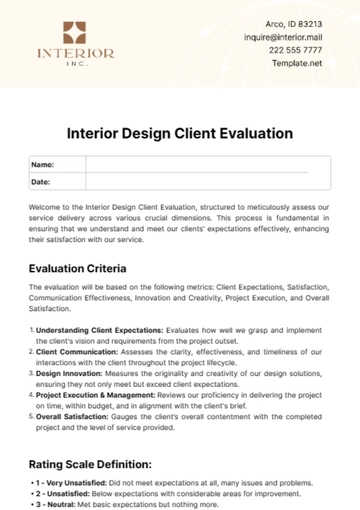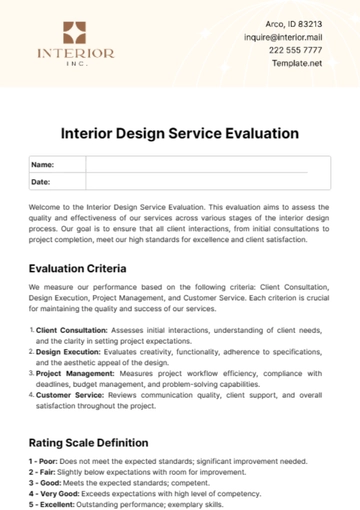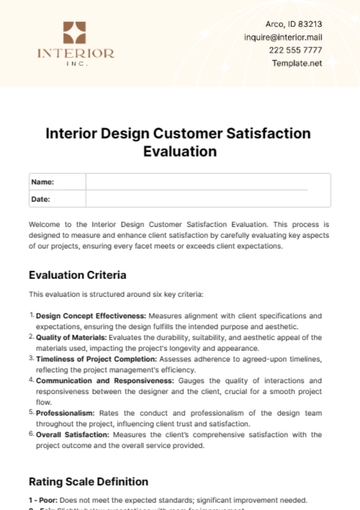Free Interior Design Risk Evaluation
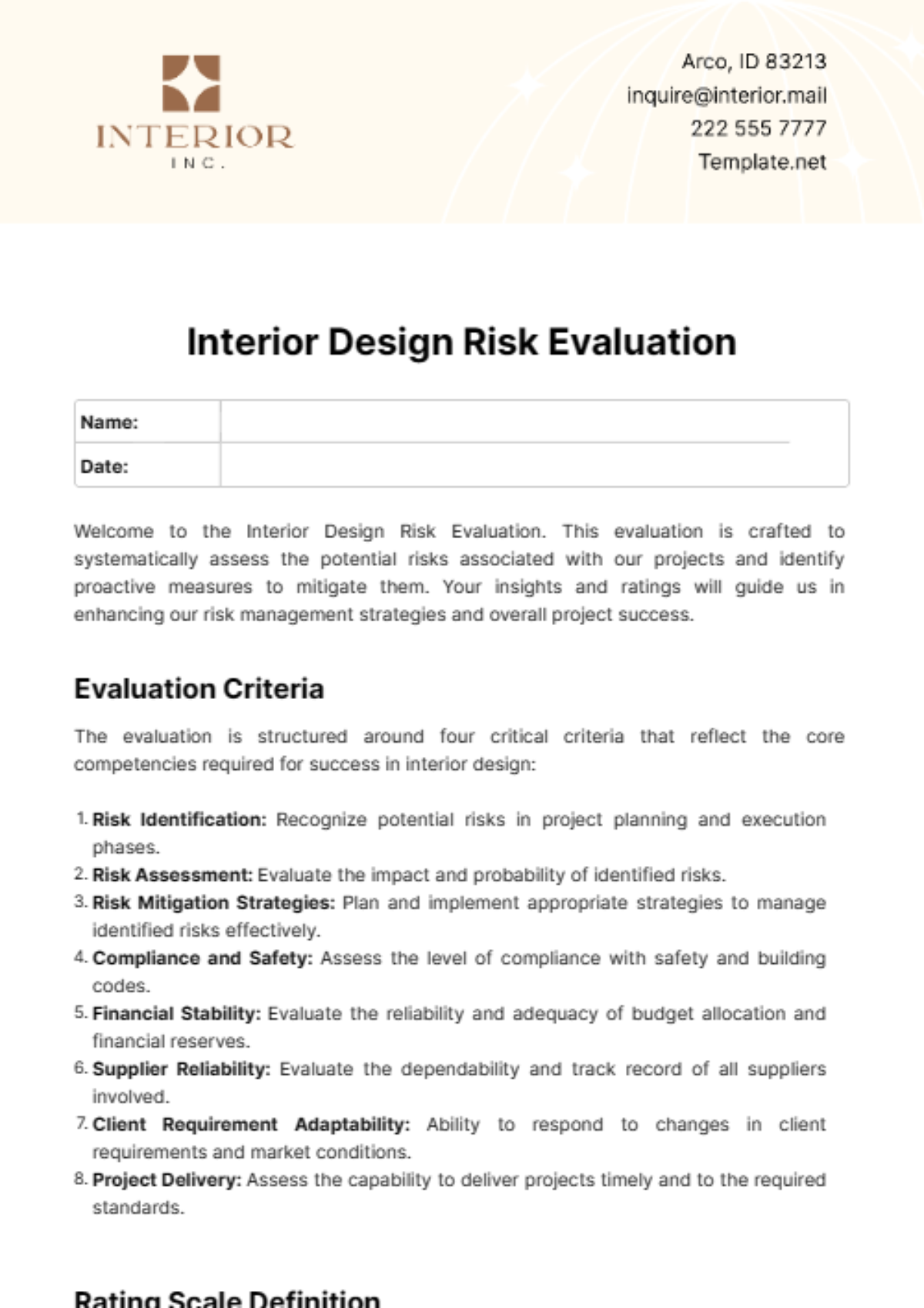
Name: | |
Date: |
Welcome to the Interior Design Risk Evaluation. This evaluation is crafted to systematically assess the potential risks associated with our projects and identify proactive measures to mitigate them. Your insights and ratings will guide us in enhancing our risk management strategies and overall project success.
Evaluation Criteria
The evaluation is structured around four critical criteria that reflect the core competencies required for success in interior design:
Risk Identification: Recognize potential risks in project planning and execution phases.
Risk Assessment: Evaluate the impact and probability of identified risks.
Risk Mitigation Strategies: Plan and implement appropriate strategies to manage identified risks effectively.
Compliance and Safety: Assess the level of compliance with safety and building codes.
Financial Stability: Evaluate the reliability and adequacy of budget allocation and financial reserves.
Supplier Reliability: Evaluate the dependability and track record of all suppliers involved.
Client Requirement Adaptability: Ability to respond to changes in client requirements and market conditions.
Project Delivery: Assess the capability to deliver projects timely and to the required standards.
Rating Scale Definition
1 - Poor: Does not meet the expected standards; significant improvement needed.
2 - Fair: Slightly below expectations with room for improvement.
3 - Good: Meets the expected standards; competent.
4 - Very Good: Exceeds expectations with a high level of competency.
5 - Excellent: Outstanding performance; exemplary management of risk.
Section 1: Risk Identification
Effective risk management starts with the accurate identification of potential risks during the planning and execution phases of a project. This section evaluates your ability to recognize these risks.
Risk Factor | Description | Rating (1-5) | Comments |
|---|---|---|---|
Design Complexity | Recognize risks related to the complexity of the design. | 4 | Successfully identifies major risks associated with complex designs, ensuring early planning. |
Environmental Factors | Potential environmental issues impacting the project. | ||
Regulatory Changes | Risks due to changes in regulatory requirements. | ||
Stakeholder Involvement | Risks associated with multiple stakeholder requirements. |
Section 2: Risk Assessment
Once risks are identified, evaluating their impact and probability is crucial. This section assesses your ability to gauge the severity and likelihood of risks occurring.
Risk Factor | Description | Rating (1-5) | Comments |
|---|---|---|---|
Impact Analysis | Assess the potential impact of identified risks. | 4 | Provides a thorough analysis of impacts, categorizing risks as high, medium, or low priority. |
Probability Estimation | Estimate the likelihood of risks materializing. | ||
Vulnerability Concerns | Evaluation of project vulnerabilities to risks. | ||
External Factors | Influence of external elements on project risks. |
Section 3: Risk Mitigation Strategies
Effective risk mitigation involves planning and implementing strategies to manage identified risks. This section evaluates your approach to developing these strategies.
Strategy | Description | Rating (1-5) | Comments |
|---|---|---|---|
Contingency Planning | Development of plans to address potential risks. | 5 | Excels in creating robust contingency plans that cover a wide range of scenarios. |
Resource Allocation | Allocation of resources to mitigate risks. | ||
Process Adjustments | Adjustments made to processes to reduce risks. | ||
Communication Improvements | Enhancements in communication to manage risks. |
Section 4: Compliance and Safety
Compliance with relevant safety and building codes is non-negotiable in mitigating risks. This section assesses adherence to these standards.
Compliance Factor | Description | Rating (1-5) | Comments |
|---|---|---|---|
Code Adherence | Level of compliance with safety and building codes. | 4 | Demonstrates high compliance with national safety standards, minimizing legal and safety risks. |
Safety Procedures | Implementation of recommended safety procedures. | ||
Inspection Readiness | Preparedness for safety inspections. | ||
Documentation Integrity | Accuracy and completeness of compliance documentation. |
Section 5: Financial Stability
Financial stability is key to enduring project challenges without compromising quality. This section evaluates the reliability and adequacy of budget allocation and financial reserves.
Financial Aspect | Description | Rating (1-5) | Comments |
|---|---|---|---|
Budget Allocation | Adequacy of the budget allocated to the project. | 4 | Effectively allocates budgets that are realistic and flexible, covering all critical areas of the project. |
Financial Reserves | Availability of financial reserves to address risks. | ||
Cost Control | Ability to control and manage project costs. | ||
Financial Risk Management | Management of financial risks to the project. |
Section 6: Supplier Reliability
The reliability of suppliers plays a critical role in project success. This section evaluates the dependability and track record of all suppliers involved.
Supplier Factor | Description | Rating (1-5) | Comments |
|---|---|---|---|
Supplier Track Record | Dependability of suppliers based on past performance. | 4 | Regularly assesses suppliers and selects only those with proven reliability and excellence in delivery. |
Supplier Communication | Quality of communication with suppliers. | ||
Material Quality | Quality of materials supplied. | ||
Delivery Timeliness | Timeliness of supplier deliveries. |
Section 7: Client Requirement Adaptability
Adapting to changes in client requirements and market conditions is essential for maintaining project relevance and client satisfaction. This section assesses your flexibility in responding to these changes.
Adaptability Factor | Description | Rating (1-5) | Comments |
|---|---|---|---|
Response to Client Changes | Ability to adapt designs to client changes. | 4 | Shows excellent flexibility in adjusting designs to accommodate client preferences and feedback. |
Market Trends Adaptation | Responsiveness to changes in market trends. | ||
Change Management | Effectiveness of change management processes. | ||
Client Feedback Integration | Integration of client feedback into the project process. |
Section 8: Project Delivery
Timely and standard-compliant delivery of projects is crucial. This section assesses the capability to deliver projects on time and to the required standards.
Delivery Aspect | Description | Rating (1-5) | Comments |
|---|---|---|---|
Timeliness of Delivery | Punctuality in project completion. | 4 | Consistently meets project deadlines, ensuring timely deliveries that align with client expectations. |
Quality Standards | Compliance with required quality standards. | ||
Project Handover | Smoothness of the project handover process. | ||
Post-Delivery Support | Quality of support provided after project delivery. |
Section 9: Additional Comments and Suggestions
This section provides space for evaluators to offer further comments and suggestions that can help in refining and improving risk management practices. It serves as an open-ended platform for additional feedback.
Aspect | Comments |
|---|---|
Overall Risk Management | |
Areas for Improvement | |
Additional Training Needed | |
Other Observations |
This structured evaluation provides a comprehensive overview of your performance in risk management across multiple critical areas. The feedback will guide enhancements in our strategies, aligning with our commitment to excellence in managing interior design projects.
- 100% Customizable, free editor
- Access 1 Million+ Templates, photo’s & graphics
- Download or share as a template
- Click and replace photos, graphics, text, backgrounds
- Resize, crop, AI write & more
- Access advanced editor
Elevate your design projects with Template.net’s Interior Design Risk Evaluation Template. This editable and customizable template, crafted for precision, seamlessly integrates risk assessment into your planning phase. Editable in our AI Editor Tool, this resource empowers you to foresee potential issues and plan effectively. Optimize project outcomes and enhance client satisfaction by incorporating this indispensable tool into your workflow today.
